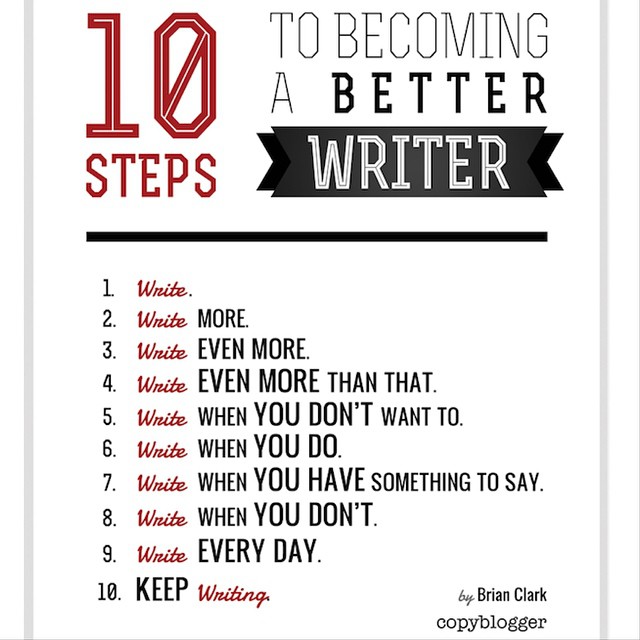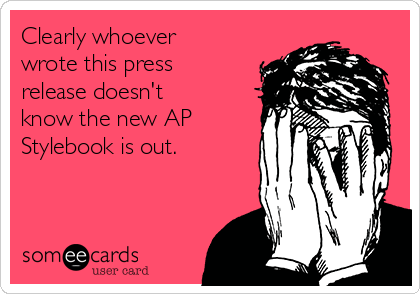1.2 The Role of Writing in Public Relations
The Role of Writing in Public Relations
Public relations professionals at all levels need to have solid writing skills. White (2016) says, “To succeed as a PR pro, it’s vital to have a passion for writing and communication, and to be committed to excelling in both. You’re bound to fail if you don’t” (para. 9). Public relations professionals are responsible for developing communication materials intended to influence the attitudes and/or behaviors of key publics. Many employers require candidates for public relations positions to complete a writing test and provide a writing sample to demonstrate proficiency in this skill. Therefore, it is critical to understand how to craft effective messages through written communication.
Here are some of the many materials and messages that public relations professionals have to write:
- Press/News releases
- Fact sheets
- Feature articles
- Social media messages
- Blog posts
- Speeches
- PowerPoint presentations
- Brochures
- Media pitches
- Statements
- Website messages
News Writing vs. Public Relations Writing
Effective public relations writing draws from news writing principles, because the news media is one of the preferred channels for promoting products and services. However, news writing and public relations writing differ in terms of audience, tone, and media channels. News writing should be objective in tone, with the purpose of presenting information to educate an audience about newsworthy events. On the other hand, public relations writing advocates for the client. It is informative, but it should also influence key publics’ perception of the organization.
Reporters usually write for one audience: readers or listeners of the respective media outlet. Public relations professionals may have to write for a variety of audiences, including internal audiences (such as employees, shareholders, and distributors) and external audiences (such as the media, customers, volunteers, and bloggers). News writing uses one primary communication channel – the news outlet (which can be a newspaper or a television or radio broadcast). Although journalists are increasingly using social media channels to post their articles, this usually entails posting a link that directs the audience to the news outlet’s primary website. Public relations professionals use a variety of channels to distribute their messages, including news media, social media, advertisements, blogs, media kits, and many more.
Good Writing
Many jobs and industries rely on good writing. Even within the public relations or communication industry, writing responsibilities can vary. You may be writing a news release, a blog post or a script for a radio ad. Maybe you’re scripting video shoots, writing speeches, drafting social or advertising content or writing a speech for the upcoming event you’re planning. Strong writing for email also helps you show your professionalism, intelligence and attention to detail.
Employers understand the cost of unclear, clunky or otherwise poor writing, and the need for clear writing threads throughout many jobs in communication, whether or not the primary job responsibility appears to be writing. Heather Whaling is the founder and CEO of Geben Communication, which specializes in traditional and digital public relations. She says, “writing is still the most important skill” in today’s digital world. Allie Lehman is the co-founder of The Wonder Jam, which has a strong focus on branding, graphics and photography. Lehman agrees, “it’s really important for students to be comfortable with writing.”
As famous basketball coach John Wooden said: “When you improve a little each day, eventually big things occur.” Writing improves with practice. The more you do something and work at it, the better you get. This is true whether you consider yourself a strong writer at the start, or someone who struggles with writing.

In her book Everybody Writes, Ann Handley makes the argument that “good writing can be learned—the way trigonometry or algebra or balancing a balance sheet is a skill most of us can master.”
The boxes below highlight some of the most common writing errors and a few ways to intentionally improve your writing.
Common Errors
- Spelling errors
- Its vs. it’s
- There vs. their
- Affect/effect confusion
- Random capitalization
- Starting sentences with numerals
- Poor sentence structure (run-ons, fragments)
- Incorrect comma use
- Incorrect semicolon use
Quick Tips
- Use simple words, short sentences
- Keep it simple by adding visuals
- Challenge ‘to be’ verbs & use active voice
- Challenge prepositional phrases
- Avoid clichés, overused phrases & jargon
- Trim any other wordiness
Also, make editing a formal step in your writing process to force yourself to analyze your own writing. Allow time for re-reading and corrections even when you’re on a tight timeline. Before you send even a brief email to a colleague, pause and read through it one final time to correct minor spelling or punctuation errors.
Reading, Resourcefulness & Curiosity
Reading can teach grammar, but it also gives you insight on different types of writing, different voices and different styles. Read newspapers, blogs, books in many genres, websites, Twitter posts, magazines. Read some things you know you’ll like and some things that will stretch you.
Be curious. If you see something new or unfamiliar or interesting, dig a little deeper.
In addition to reading and exploring things that pique your curiosity, there are many resources to help novice writers grow and to help expert writers continue to advance. Take advantage of colleagues, mentors, bosses and educators who are willing to review your work and give constructive criticism.
There are also amazing resources out there as references when you have questions, need edits or just want to explore ways to step up your writing game. They can help whether you’re Pulitzer-worthy or not able to recognize a run-on sentence. A few to check out include:
- Grammar Girl. Mignon Fogarty, also known as Grammar Girl, explores many common grammar questions with a fun, easy-to-understand style. Check out her website or social media platforms, or listen in on her podcasts.
- Everybody Writes: Your Go-To Guide to Creating Ridiculously Good Content. Marketing veteran Ann Handley writes a great book that goes from writing basics to best practices.
- Grammar Bytes: Grammar Instruction with Attitude
- Apps, websites and browser plugins. Do a little digging to see what’s out there. Things like Grammarly, which can help check your spelling and grammar, or Hemingway Editor, which focuses on making writing more concise and readable.
Canadian Press Style
The majority of journalists and public relations practitioners in Canada use CP Style, based on the Canadian Press Stylebook. As the foundation for journalistic writing, this style focuses on achieving the best possible accuracy and consistency to make content easily read and understood by readers. This translates to the public relations arena because:
- Adhering to a consistent style improves readability and brand recognition.
- Using CP style gives you a common language with journalists, who will often incorporate your messages into the stories they write.
Many public relations agencies and corporations interviewing potential employees will require a CP style writing or copyediting test to ensure new hires come in able to write in this style from day one. In the US they used Associated Press or AP Style.
Know the Basics
It’s worth your time to learn the basics of CP style that will surface again and again in your writing.
- Dates
- Numerals
- Dollars & percents
- Times
- Addresses
- Titles
- Names
- Composition titles
- Abbreviations
- Social media use
There are a few guiding CP style rules to memorize, but keep a hard copy or online version of the book handy for reference when other questions emerge. Like the English language, there are exceptions to many of the rules, but a few of the often-used CP style standards include:
Every word has one and only one spelling.
- Check the stylebook first – then a dictionary. CP style occasionally has “preferred” spellings.
Avoid unnecessary capitalization.
- Far fewer words should be capitalized than you think.
- Always look it up before you capitalize anything other than proper names.
Avoid excessive abbreviation.
Punctuate according to generally accepted rules.
In general, spell out zero through nine.
- Many exceptions and contingencies to this rule.
- Pay attention and memorize.
They stylebook is updated regularly and published. Some years, the changes are minimal, and other years they are more significant. Many times organizations will use CP style as their overarching style but customize specifics such as how to abbreviate the organization’s name or whether to capitalize the names of its boards or committees.


